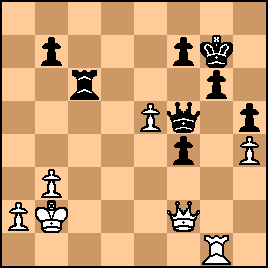| Sep-04-24 | | mel gibson: I should have seen that -
I needed to spend longer than 10 seconds.
Stockfish 16.1 says:
34. .. Rxd3
(34. .. Rxd3 (1. ... Rxd3 2.cxd3 Qxd3+ 3.Kb2 Be2 4.a4 Qd2+ 5.Ka3 b5 6.Rxg6+ fxg6 7.Qa7+ Kh6 8.Qb8 b4+ 9.Qxb4 Qxb4+
10.Kxb4 f3 11.Ra1 f2 12.e6 Rxe6 13.Kc5 Re4 14.Kc6 f1Q ) +39.12/43 479) score for Black +39.12 depth 43. |
|
| Sep-04-24 | | Allderdice83: I saw 34 ... Rxd3. I was assuming after 35 ... Qxd3+ that White would play 36. Ka1, and then 35 ... Rc2 is the finisher (of course White can give up the queen for a rook but that will be an easily won endgame for Black). When I saw 36. Kb2, I was thinking 36 ... Qc3+ but quickly saw that that went nowhere. So, then I figured if I could block the queen, then the rook could get to c2. Ergo, 36 ... Be2. Now 37. Rc1 Qd2+ leads to mate (a pretty line is 38. Ka3 Ra6#). Or 37. Qxe2 Qxe2+ 38. Ka1 Rc2 39. R5g2 Rxa2+ 40. Kb1 Qxg2 41. Rxg2 Rxg2 wins easily. |
|
Sep-04-24
 | | scormus: Look a while to see, the sequence didn't immediately shout at me to me played.
The keys are eliminating the Bd3 which was holding W's position together, and finding a way to block the WQ defending along the 2nd rank. |
|
| Sep-04-24 | | TheaN: Played this is a bit suboptimal. Somehow couldn't find the correct bishop moves. <34....Rxd3> was kind of obvious, considering we're in a Sicilian double flank attack and White's about to do the same. Mind that now, 35.R5xg4 (R1xg4?? Rd1#) I'd play 35....Rd2 -+, though hxg4 is even stronger because the pawns move fast. So, <35.cxd3 Qxd3+ 36.Kb2 (Ka1 Rc2 -+)>:

click for larger view
We want the bishop to get involved, with or without Qc3+. Astonishingly enough, I spotted Bf5 and Bd1 instantly. Not the winning 36....Be2!, or 36....Qc3+ 37.Kb1 Bf3!, both following the same idea, the queen's attacking the bishop that's defended, and the next move's a deadly check. After 36....Bd1?! 37.Rxd1 Qxd1 -+ complicates matters, though still won. I however chose <36....Qc3+ 37.Kb1 Bf5+?!>, which is the worst winning continuation after Qc3+. Now <38.Rxf5 Qd3+ 39.Kb2 Qxf5 -+> is forced. Black's winning, e5 will fall, the Black position is solid so the king side pawns run fast, but there's still work to be done as it's a major piece endgame +2♙. |
|
Sep-04-24
 | | Sally Simpson: Interesting game.
34...Rxd3 from a set diagram jumps out at you. Type of move you know you are going to play so just play it. What else is there. Back here;

click for larger viewWhite has just played 33.Rg1-g3 so they too had spotted the coming Rxd3 exchange sac. Instead of working out if grabbing the Rook and wriggling like an eel to escape the perpetual after Qf6+ and Rxg6 (if indeed he can and there is one) he played the cool headed 33....Rc6. |
|
Sep-04-24
 | | chrisowen: Lap jufa z its cud Rxd3 abbot lab v finish its aoe its jet afford pod io its ho its aea oar Rxd3 dim. |
|
| Sep-04-24 | | TheaN: Coming back to my suboptimal line, the position after 36....Qc3+ 37.Kb1 Bf5+?! 38.Rxf5 Qd3+ 39.Kb2 Qxf5:

click for larger view
May not be so difficult after all. White will have to defend e5 immediately or just go into a hopeless endgame. The queen's not a proper choice due to the Rc2+ threat, so 40.Re1. Now 'simply' 40....Re6 works. SF gives as White's best 41.Qc2, but trading down will just help Black, after 41....Qxc2+ 42.Kxc2 f6 -+ the f4-pawn will pin down White's pieces and it's cruising from here. |
|
Sep-04-24
 | | chrisowen: X Dindins x |
|
Sep-04-24
 | | Knightf7mate: I couldn’t find the move 36..Be2, blocking the white queen. Of course without seeing that, you are down a rook for a knight and pawn. After seeing up to 36. Kb2 it took very little time to find the move. This pretty much sums up my game. I was looking for ways to see how to bring the bishop into the attack on the king but the water was too deep for me to see it at move 34 |
|
| Sep-04-24 | | Rosbach: A possible continuation after 36 Be2 could be 37. e6 Rc2+ 38. Ka3 Qa6+ 39. Kb4 Qd6+ 40. Ka5 Rxa2# |
|





